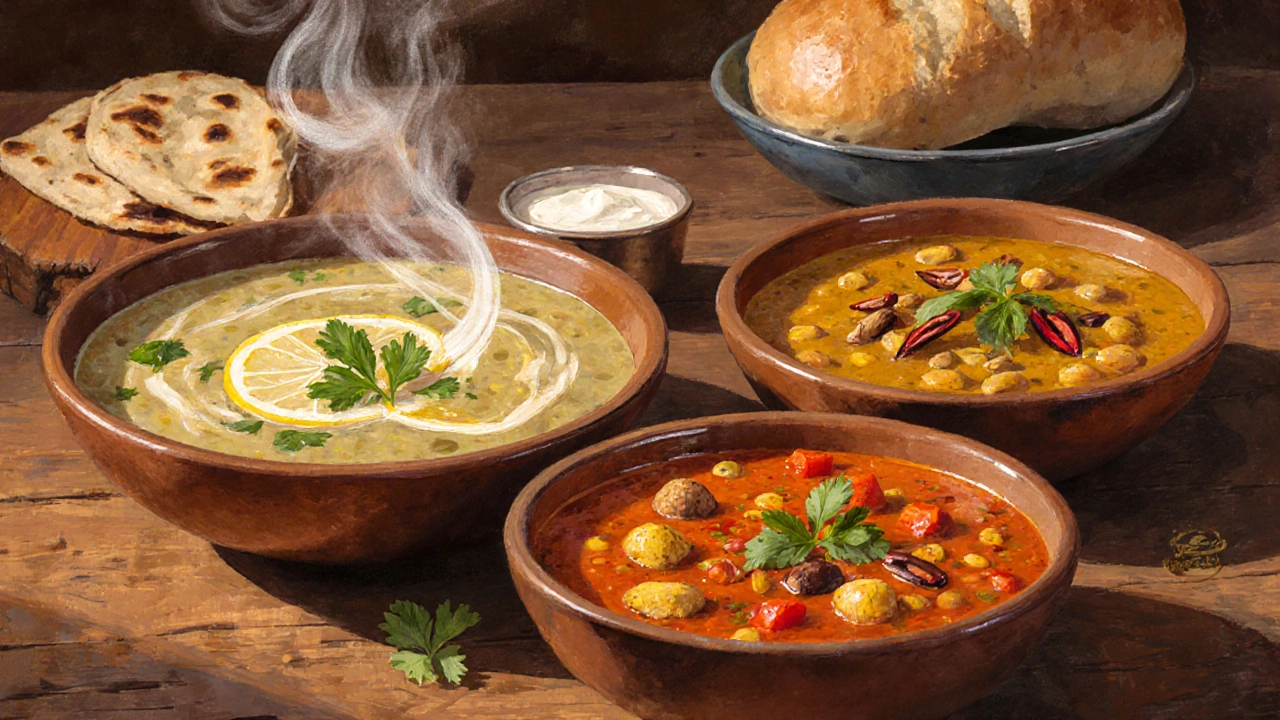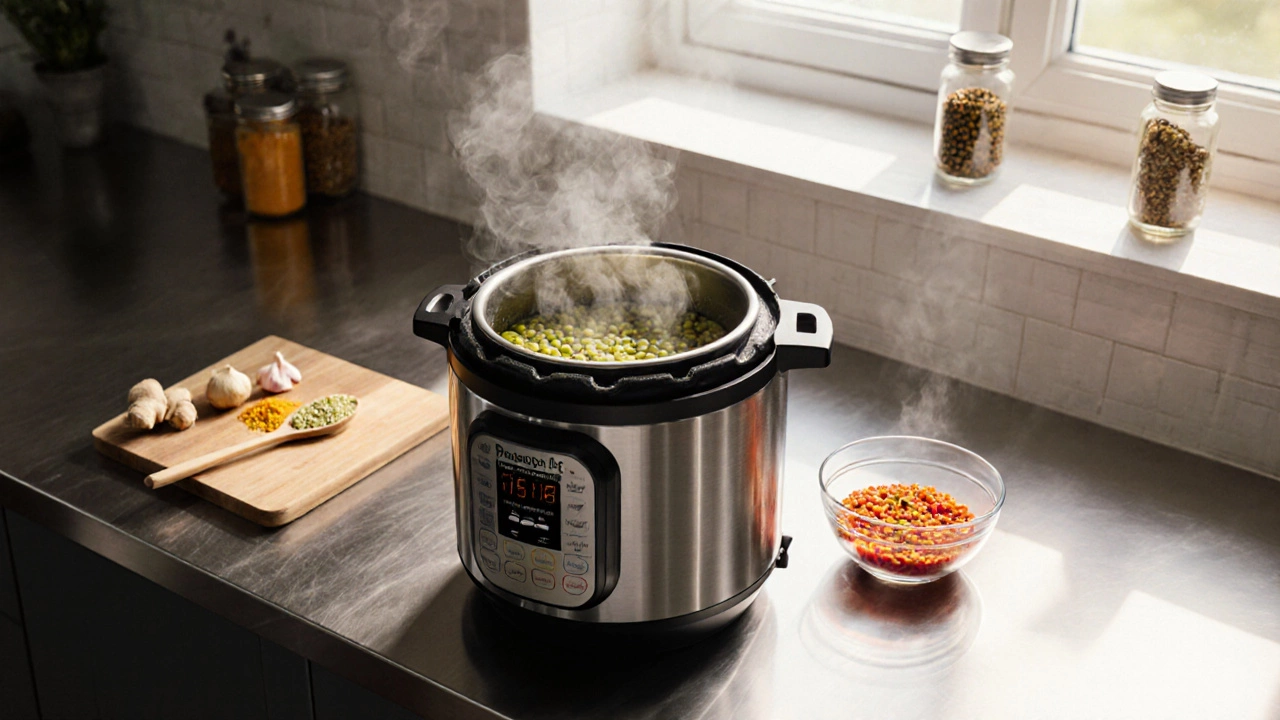Dal Cooking Time Calculator
Estimated Cooking Time
Pro Tip: Always rinse thoroughly before cooking.
For stovetop: Use 1:3 dal-to-water ratio
Quick Takeaways
- Moong dal (split green gram) and masoor dal (red lentils) cook perfectly without any pre‑soak.
- Urad dal (split black gram) and chana dal (split chickpeas) need only a short 15‑minute soak, but you can also pressure‑cook them straight away.
- Using a pressure cooker or an Instant Pot cuts cooking time dramatically for all dals.
- Rinse the dal well, add a pinch of turmeric, and start with a 1:3 dal‑to‑water ratio for fluffy results.
- Quick‑cook recipes like dal tadka, simple dal soup, or dal‑based salads keep the meal ready in under 30 minutes.
When it comes to Indian cooking, dal is a collective term for dried legumes such as lentils, split peas, and beans, used as a staple protein source in many households. Soaking the dal overnight is a habit many of us learned from grandparents, but it adds extra planning time. Thankfully, not all dals need that ritual. Below you’ll find the exact varieties that can go straight from the pantry to the pot, plus tips to get them tender in record time.
Why Soaking Is Commonly Recommended
Soaking serves three purposes:
- Softening: Water penetrates the seed coat, reducing the required cooking time.
- Reducing anti‑nutrients: Soaking helps break down phytic acid and enzyme inhibitors, making minerals more bioavailable.
- Even cooking: It minimizes the risk of a hard core while the outer layer becomes mushy.
But modern cookware-especially pressure cookers-does most of this work for you. The key is picking a dal whose seed coat is already thin enough to hydrate quickly.
Dal That Naturally Skip Soaking
Here are the top five pulses that need no pre‑soak at all:
Moong dal (split green gram)
Moong dal has a delicate skin that absorbs water instantly. In a regular saucepan, it becomes tender in 12‑15 minutes; in a pressure cooker, just 2 whistles (about 5 minutes). It’s perfect for light, buttery dals, sprouted salads, and sweet desserts like moong halwa.
Masoor dal (red lentils)
Red lentils break down quickly, turning creamy without any soaking. A quick simmer of 8‑10 minutes yields a smooth consistency ideal for dal makhani‑style gravies, soups, or thickening curries.
Toor dal (split pigeon peas)
While many recipes call for a 30‑minute soak, toor dal’s split nature allows it to cook in about 20 minutes on the stovetop or 6 minutes in a pressure cooker without soaking. Use it for classic sambar or simple dal tadka.
Urad dal (split black gram)
Urad dal has a slightly thicker coat, so a short 15‑minute soak helps, but you can also skip soaking by adding extra water and using a pressure cooker (3 whistles). It’s the backbone of South Indian dosa batter and rich dal fry.
Chana dal (split chickpeas)
Chana dal benefits from a brief soak, yet the pressure cooker makes soaking unnecessary. Cook it for 8‑10 minutes at high pressure and you’ll get a tender bite perfect for chana dal tadka or a protein‑packed soup.
How to Cook Soak‑less Dals Perfectly
Follow these universal steps for fluffy, non‑gooey results:
- Rinse thoroughly: Place the dal in a sieve and rinse under running water until the water runs clear. This removes dust and surface enzymes.
- Use the right water ratio: For stovetop, a 1:3 dal‑to‑water ratio works well. For pressure cooking, 1:2.5 prevents overflow.
- Add aromatics early: A pinch of turmeric, a few cloves of garlic, and a small piece of ginger infuse flavor while the dal softens.
- Cook at medium‑low heat: Let the dal simmer gently; a rapid boil can cause the outer layer to burst, leaving the center hard.
- Check for doneness: Taste a grain; it should be soft but not mushy. If needed, add a splash of water and continue for another minute.
- Finish with tempering (tadka): Heat oil or ghee, add mustard seeds, cumin, dried red chilies, and curry leaves. Pour over the cooked dal for that classic pop of flavor.
Quick Recipes Using No‑Soak Dals
1. Simple Moong Dal Soup
- 1 cup moong dal, rinsed
- 4 cups water or vegetable broth
- ½ tsp turmeric, 1 tsp grated ginger, salt to taste
- Finish with a drizzle of lemon juice and chopped cilantro.
Cook the dal until soft, blend half for a creamy texture, and serve hot. Ready in under 20 minutes.
2. Red Lentil Dal (Masoor)
- 1 cup masoor dal, rinsed
- 3 cups water
- 1 diced tomato, 1 tsp cumin seeds, 1 tsp garam masala
- Finish with a tempering of mustard seeds and curry leaves.
Simmer for 10 minutes, add the spices, and let it thicken. Great over rice or with naan.
3. Pressure‑Cooked Toor Dal Tadka
- 1 cup toor dal, rinsed
- 2 ½ cups water
- ½ tsp turmeric, ½ tsp asafoetida (hing)
- Temper with 1 tsp mustard seeds, 2 dried red chilies, and a pinch of curry leaves.
Cook on high pressure for 6 minutes, release pressure naturally, then add the tempering. Serve with steamed rice.

Common Mistakes & How to Avoid Them
- Using too little water: Dals expand up to three times their size. Keep an eye on the pot and add a splash if it looks dry.
- Skipping the rinse: Unwashed dal can cause bitter flavors and cloudy broth.
- Cooking on high flame: Quick boils break the skin and trap steam inside kernels, leaving a hard center.
- Over‑tempering: Adding too much oil or too many spices at the end can mask the dal’s natural flavor.
Choosing the Right Dal for Your Schedule
If you’re pressed for time, stick to dal without soaking varieties like moong and masoor. For heartier dishes that benefit from a nutty bite, use pressure‑cooked urad or chana dal and enjoy the same convenience.
Frequently Asked Questions
Do I really need to soak any dal if I have a pressure cooker?
A pressure cooker speeds up the softening process, so even traditionally soaking‑required dals like urad or chana become tender in 5‑8 minutes without a pre‑soak. Just add a bit more water to avoid scorching.
Can I use canned dal instead of dried?
Canned dal is already cooked, so you only need to heat it with spices. It’s convenient for quick meals but watch the sodium level as many cans are salted.
What’s the nutritional difference between soaked and unsoaked dal?
Soaking slightly reduces anti‑nutrients like phytic acid, making minerals a bit more absorbable. The impact on protein or fiber is minimal, so cooking without soaking doesn’t diminish the health benefits.
Can I freeze cooked dal?
Yes. Portion the cooked dal into airtight containers, label with the date, and store for up to three months. Thaw and reheat with a splash of water to revive the texture.
Why does my dal turn mushy when I add too much water?
Excess water breaks down the starches rapidly, giving a porridge‑like consistency. Stick to the recommended ratio and remove the lid toward the end to let extra liquid evaporate.
With the right dal and a few smart shortcuts, you can ditch the overnight soak and still enjoy perfectly tender, flavorful dishes. Whether you’re whipping up a weekday dal tadka or preparing a hearty soup for a weekend brunch, these soak‑less options keep your kitchen running smoothly.
